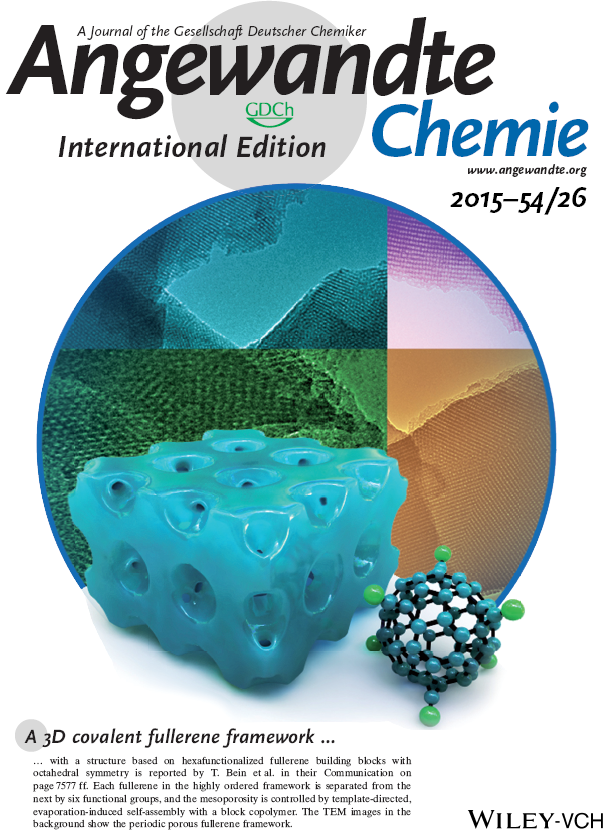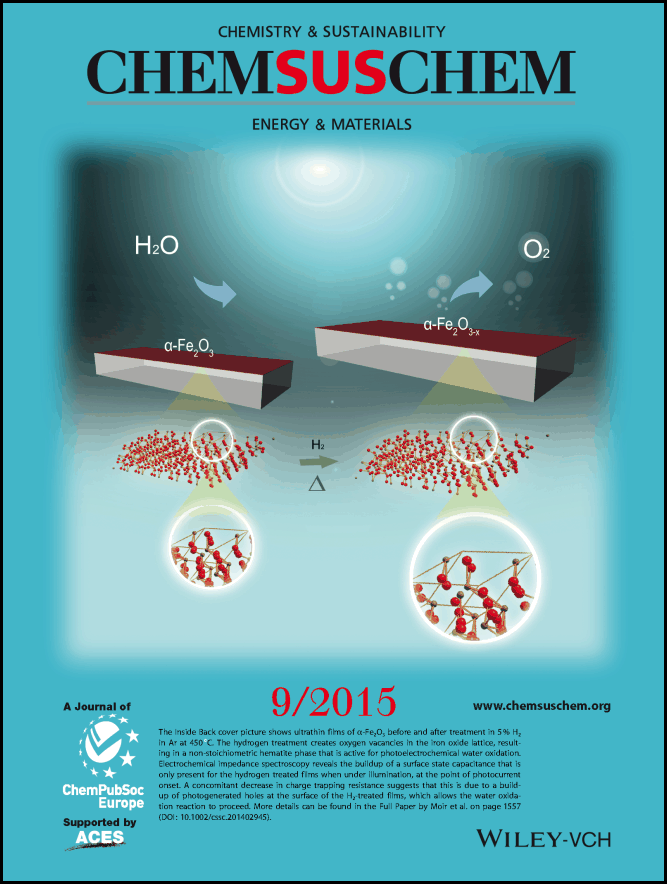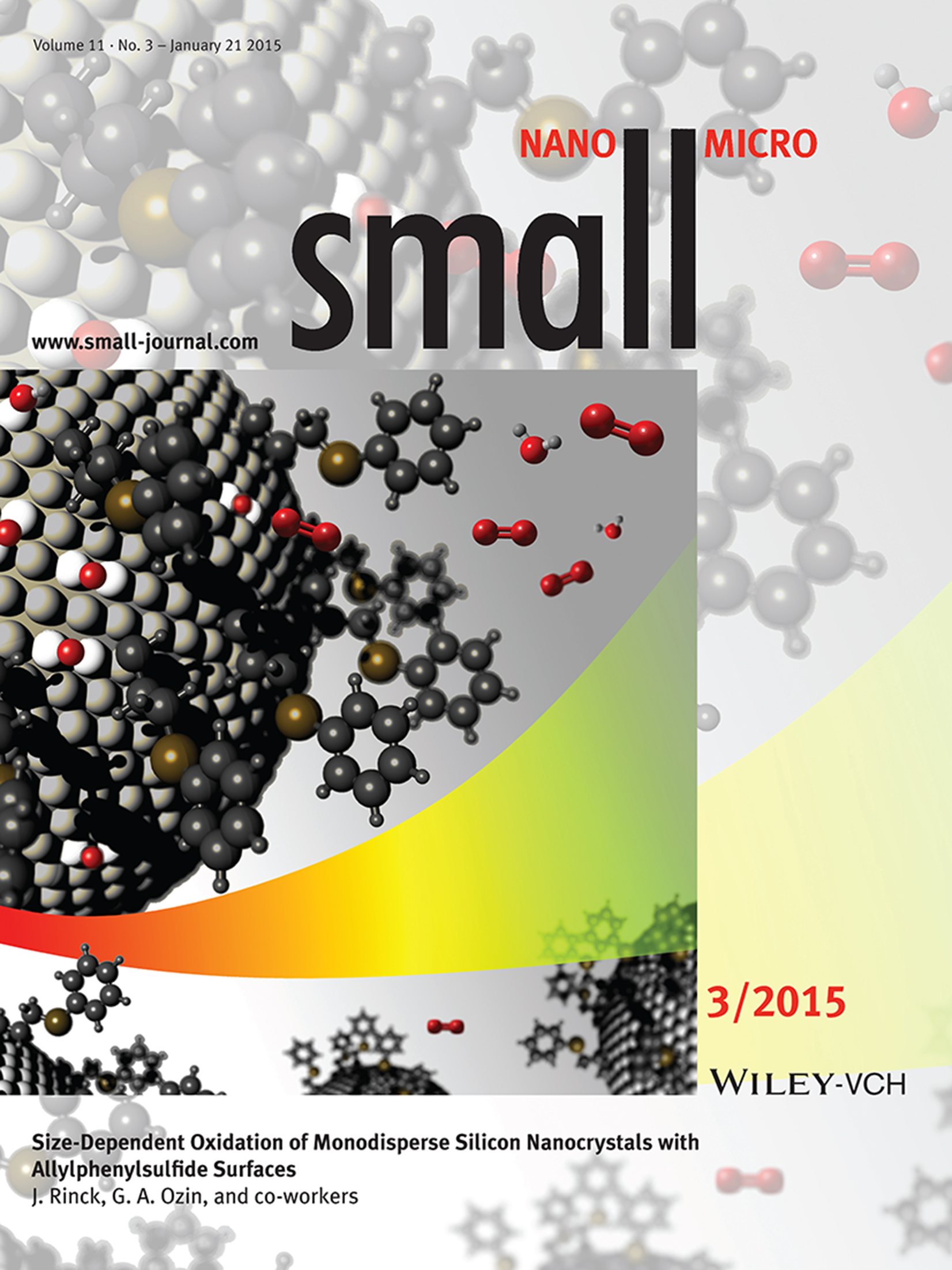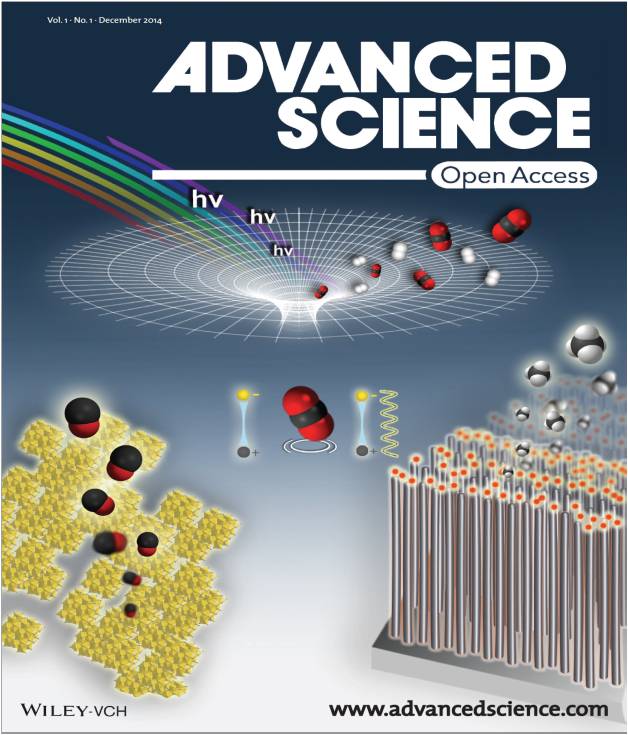| Front Cover Gallery | |
|---|---|
 |
A Highly-Ordered 3D Covalent Fullerene Framework
Norma Minar, Kun Hou, Christian Westermeier, Dr. Markus Döblinger, Dr. Jörg Schuster, Fabian C. Hanusch, Dr. Bert Nickel, Prof. Dr. Geoffrey A. Ozin and Prof. Dr. Thomas Bein A 3D covalent fullerene framework with a structure based on hexafunctionalized fullerene building blocks with octahedral symmetry is reported by T. Bein et al. in their Communication on page 7577 ff. Each fullerene in the highly ordered framework is separated from the next by six functional groups, and the mesoporosity is controlled by template-directed, evaporation-induced self-assembly with a block copolymer. The TEM images in the background show the periodic porous fullerene framework. |
 |
Activation of Ultrathin Films of Hematite for Photoelectrochemical Water Splitting via H2 Treatment
Jonathon Moir, Dr. Navid Soheilnia, Dr. Kristine Liao, Dr. Paul O’Brien, Yao Tian, Prof. Kenneth S. Burch and Prof. Geoffrey A. Ozin The Inside Back cover picture shows ultrathin films of α-Fe2O3 before and after treatment in 5 % H2 in Ar at 450 °C. The hydrogen treatment creates oxygen vacancies in the iron oxide lattice, resulting in a non-stoichiometric hematite phase that is active for photoelectrochemical water oxidation. Electrochemical impedance spectroscopy reveals the buildup of a surface state capacitance that is only present for the hydrogen treated films when under illumination, at the point of photocurrent onset. A concomitant decrease in charge trapping resistance suggests that this is due to a build-up of photogenerated holes at the surface of the H2-treated films, which allows the water oxidation reaction to proceed |
 |
Exploring the Possibilities and Limitations of a Nanomaterials Genome
Chenxi Qian, Todd Siler, and Geoffrey Ozin The rapid development of nanomaterials science and technology nowadays calls for a multifunctional data system, namely the Nanomaterials Genome, outlined on page 64. It is designed for intelligent and convenient categorizing, organizing, sifting, sorting, and integrating pertinent information about the known nanomaterials, and utilizing this information to explore the unknown in scientifically and technologically innovative ways, ultimately to benefit society. |
 |
Si Nanocrystals Front Cover in Small
Julia Rinck1, Dirk Schray, Christian Kübel, Annie K. Powell, and Geoffrey A. Ozin Adding a sulfur atom to allylbenzene is shown by J. Rinck, G. A. Ozin, and co-workers to boost the photoluminescence quantum yield of colloidal dispersions of silicon nanocrystals capped with allylphenylsulfide. On page 335, it allows investigation of their oxidative stability as a function of size and duration of exposure to air. The illustration depicts the allyphenylsulfide capping groups on the surface of the silicon nanocrystals, and the reaction of the nanocrystals with O2 and H2O molecules in air, forming surface silicon oxide and silicon hydroxide groups. |
 |
Solar Refinery Papers in Advanced Science
Paul G. O’Brien, Amit Sandhel, Thomas E. Wood, Abdinoor A. Jelle, Laura B. Hoch, Doug D. Perovic, Charles A. Mims and Geoffrey A. Ozin AND Laura B. Hoch, Thomas E. Wood, Paul G. O’Brien, Kristine Liao, Laura M. Reyes, Charles A. Mims and Geoffrey A. Ozin The cover art, courtesy of Chenxi Qian, illustrates the concept of how “black holes” for photons, phonons, excitons and molecules, in two new classes of nanostructure, allow light-assisted, gas-phase heterogeneous catalytic CO2 reduction to CO or CH4. The ultimate goal of this research is to facilitate an energy transition from today’s unsustainable “fossil fuel economy” of burn-and-adapt to greenhouse gas climate change to a new and sustainable “carbon dioxide economy”, where greenhouse gas emissions are utilized as a chemical feed stock rather than being treated as a waste product. |
 |
Special Issue of Can. J. Chem Dedicated to Prof. Ozin
Geoffrey A. Ozin The Canadian Journal of Chemistry has published a special issue dedicated to Prof. Ozin on the occasion of his 70th birthday. The issue contains several articles from group alumni and a tribute to Geoff by Prof. George Whitesides from Harvard University. |
 |
Silicon Nanocrystal OLEDs: Effect of Organic Capping Group on Performance
Melanie Mastronardi, Eric Henderson, Daniel Puzzo, Yilu Chang, Zhi Bin Wang, Michael Helander, Junho Jeong, Nazir P. Kherani, Zhenghong Lu, and Geoffrey A. Ozin The synthesis of highly luminescent, colloidally-stable and organically-capped silicon nanocrystals (ncSi) and their incorporation into a visible wavelength organic light-emitting diode (OLED) is reported. By substituting decyl chains with aromatic allylbenzene capping ligands and size-selecting visible emitting ncSi, superior packing density, enhanced charge transport, and an improved photoluminescence absolute quantum yield of the ncSi is obtained in the active layer of an OLED. |
 |
Spin of a Nanotech Spinoff
Geoffrey A. Ozin Innovation in advanced technology often springs from ideas birthed in universities yet the attitudes of professors and their students towards entrepreneurship and their stance on the collision between fundamental research in the pursuit of knowledge and applied research directed to the creation of intellectual property, inventions, companies, jobs, products, and wealth, is not that well appreciated either inside or outside our universities. In this article I will explore this interesting issue and try to gain some insight into the challenges faced by professors confronted by the challenge of transforming basic science and engineering knowledge into products in the market place, using nanotechnology as a case study. While the specific focus of this article is on nanotechnology, more generic issues are also raised that relate to transformational business development and entrepreneurship in society and universities in a larger sense. |
 |
Small Silicon, Big Opportunities
Melanie Mastronardi, Eric Henderson, Daniel Puzzo, and Geoffrey A. Ozin Nanomaterials are becoming increasingly widespread in consumer technologies,but there is global concern about the toxicity of nanomaterials to humans and the environment as they move rapidly from the research laboratory to the market place. With this in mind, it makes sense to intensify the nanochemistry community’s global research effort on the synthesis and study of nanoparticles that are purportedly “green”.One potentially green nanoparticle that seems to be a most promising candidate in this context is silicon,whose appealing optical,optoelectronic, photonic, and biomedical attributes are recently gaining much attention. In this paper, we outline some of our recent contributions to the development of the growing field of silicon nanocrystals (ncSi) in order to stress the importance of continued study of ncSi as a green alternative to the archetypal semiconductor nanocrystals like CdSe, InAs, and PbS. While a variety of developments in synthetic methods, characterization techniques, and applications have been reported in recent years, the ability to prepare colloidally stable monodisperse ncSi samples may prove to have the largest impact on the field, as it opens the door to study and access the tunable size dependent properties of ncSi. Here, we summarize our recent contributions in size-separation methods to achieve monodisperse samples,the characterization of size-dependant property trends, the development of ncSi applications, and their potential impact on the promising future of ncSi. |
 |
Solution Phase Synthesis of Carbon Quantum Dots as Sensitizers for TiO2 Solar Cells
Peter Mirtchev, Eric Henderson, Navid Soheilnia, Christopher Yip, and Geoffrey A. Ozin Carbon quantum dots (CQDs) have recently emerged as viable alternatives to traditional semiconductor quantum dots because of their facile and low cost synthesis, long term colloidal stability, and low environmental and biological toxicity. The compatible surface chemistry, good solubility in polar solvents and extensive optical absorption throughout the visible and infrared wavelength regions render CQDs as potentially useful sensitizers for photovoltaic applications. Presented herein is a new strategy for the solution phase synthesis of water-soluble, colloidally stable CQDs and a preliminary exploration of their utilization as sensitizers in nanocrystalline TiO2 based solar cells. Under AM 1.5 illumination, the Voc and FF values reach 380 mV and 64% respectively, achieving a power conversion efficiency of 0.13%, the highest reported to date for carbon/graphene nanomaterials. |
 |
Hierarchical Nanoparticle Bragg Mirror
Engelbert Redel, Chen Huai, Michael Renner, Georg von Freymann, and Geoffrey A. Ozin The cover picture shows a new kind of broadband optical reflector made by bottom-up self-assembly of nanoparticle metal-oxide multilayers fashioned as hierarchical nanoporous tandem and gradient Bragg mirrors. The optical properties of this genre of Bragg mirror can be passively tuned through variations of the composition of the nanoparticle metal-oxide layers and actively tuned through reversible adsorption–desorption of different molecular species in the nanopores, thereby providing myriad opportunities for the management of light in solar cells, photocatalysts, and photonic nose sensors in novel ways. For more information, please read the Full Paper “Hierarchical Nanoparticle Bragg Mirrors: Tandem and Gradient Architectures” by G. A. Ozin and co-workers, beginning on page 3465. Artwork credit: Wendong Wang. |
 |
Mesoporous materials: Why PMO? Towards Functionality and Utility of Periodic Mesoporous Organosilicas
Wendong Wang, Jennifer E. Lofgreen and Geoffrey A. Ozin Writing on the pore wall with a synthetic quill is the idea illustrated in the cover image. This idea captures the role of creative materials chemistry in the development of a novel class of materials called periodic mesoporous organosilica (PMO) since its inception a decade ago. Through the fusion of organic chemistry and inorganic materials chemistry, PMO has grown to possess a variety of new and exciting compositions, properties, and functions. Through a handful of recent trendsetting case histories, the cross-disciplinary applications of PMO in chemistry and physics, materials science and engineering, biology, and medicine are demonstrated in a most powerful way. In doing so, the Review that this image features aims to inspire more collaborative and ambitious endeavors in the second decade of PMO research. For more information, please read the Review ?Why PMO? Towards Functionality and Utility of Periodic Mesoporous Organosilicas? by G. A. Ozin and co-workers beginning on page 2634. |
 |
Photonic Sensors: Towards the Photonic Nose: A Novel Platform for Molecule and Bacteria Identification
Leonardo D. Bonifacio 1, Daniel P. Puzzo 1, Simon Breslav 2, Barbara M. Willey 3, Allison McGeer 3, Geoffrey A. Ozin 1 *; 2010, 22, 12 On p. 1351, Geoffrey Ozin and co-workers report on a novel artificial nose system dubbed the photonic nose, which is based on a simple and cost-effective pixelated array of surface-functionalized nanoporous Bragg mirrors that enable discrimination of different vapor phase analytes, exemplified by alkanes and alcohols as well as molecules comprising the headspace of different bacteria, detected and analyzed by diagnostic changes in red, green and blue color levels recorded by a digital camera. |
 |
Nanolocomotion – Catalytic Nanomotors and Nanorotors
Tihana Mirkovic, Nicole S. Zacharia, Gregory D. Scholes, Geoffrey A. Ozin, Small, 2010,6, 159-167 Do the nanolocomotion with me: while it is well known that solution-phase chemistry provides a powerful means to synthesize nanostructures with controlled size and shape it is only very recently that chemistry has been used as a power source to make these nanostructures move in solution well beyond the Brownian limit. The cover illustration depicts four types of motion observed for bimetallic Au-Pt nanorod motors, chemically powered by the catalytic decomposition of hydrogen peroxide fuel to water and oxygen at the platinum segment. The motility modes include straight motion with stochastically occurring turns, rotation with one end tethered to the substrate, orbiting, spinning around its center of mass, and cooperative rotational mobility of two nanorods. |
 |
The Best of Advanced Materials, No 2
Advanced Materials cover graphic illustration of a high resolution transmission electron micrograph image of ultrathin bismuth sulphide nanowires with unprecedented diameter of only 1.6 nm, a size that bridges the fuzzy regime between molecular and nanoscopic depicts the dawn of the beginning of something new and exciting in materials chemistry and nanochemistry, emerging fields that never tire of reinventing themselves. |
 |
Mesoporous Materials: Dye-Anchored Mesoporous Antimony-Doped Tin Oxide Electrochemiluminescence Cell, Kun Hou, Daniel Puzzo, Michael G. Helander, Shun S. Lo, Leonardo D. Bonifacio, Wendong Wang, Zheng-Hong Lu, Gregory D. Scholes, Geoffery A. Ozin, Advanced Materials, 2009, 21, 2492-2496 |
 |
Spatially Localized Photoluminescence at 1.5 Micrometers Wavelength in Direct Laser Written Optical Nanostructures, Sean Wong, Oliver Kiowski, Manfred Kappes, Jörg K. N. Lindner, Nirajan Mandal, Frank C. Peiris, Geoffrey A. Ozin, Michael Thiel, Markus Braun, Martin Wegener, Georg von Freymann, Adv. Mater. 2008, 20, 4097 |
 |
PInk and ElastInk: Lab-to-Market, Geoffrey A. Ozin, Z. Anorg. Allg. Chem. 2008, 634, |
 |
Cademartiri, L., Malakooti, R., Migliori, A., Ozin, G.A. “Ultranarrow Sb2S3 Nanowires” Journal of Materials Chemistry, 2008, 18, 66 |
| Cademartiri, L., Malakooti, R., Migliori, A., Ozin, G.A. “Ultranarrow Sb2S3 Nanowires” Journal of Materials Chemistry, 2008, 18, 66 | |
 |
Van Vekris, Vlad Kitaev, Doug Perovic, Stewart Aitchison and Geoff Ozin “Visualization of Stacking Faults and their Formation in Colloidal Photonic Crystal Films” Advanced Materials 2008, 8 |
 |
E. Vekris, G. A. Ozin, V. Kitaev “Curling Colloidal Photonic Crystals” Advanced Materials 2006, 18, 2481 |
 |
A. C. Arsenault, T. J. Clark, G. von Freymann, L. Cademartiri, R. Sapienza, J. Bertolotti, E. Vekris, S. Wong, V. Kitaev, I. Manners, R. Z. Wang, S. John, D. S. Wiersma, G. A. Ozin “From colour fingerprinting to the control of photoluminescence in elastic photonic crystals” Nature Materials 2006, 5(3),179-184 |
 |
B. D. Hatton, K. Landskron, W. J. Hunks, M. R. Bennett, D. Shukaris, D. D. Perovic and G. A. Ozin Materials chemistry for low- k materials Materials Today 2006, 9(3), 22-31 |
 |
F. Fleischhaker, A. C. Arsenault, Z. Wang, V. Kitaev, F. C. Peiris, G. von Freymann, I. Manners, R. Zentel, G. A. Ozin “Redox-Tunable Defects in Colloidal Photonic Crystals” Advanced Materials 2005, 17(20) |
 |
Ulrich Kamp, Vladimir Kitaev, Georg von Freymann, Geoffrey A. Ozin, Scott A. Mabury “Colloidal Crystal Capillary Columns – Towards Optical Chromatography” – Advanced Materials 2005, 17(4), 438-443 |
 |
Sebastien Fournier-Bidoz, André C. Arsenault, Ian Manners, Geoffrey A. Ozin, “Synthetic Self-Propelled Nanorotors” – ChemComm 2005, 4, 441 |
 |
Sung Yeun Choi, Marc Mamak, Scott Speakman, Naveen Chopra, Geoffrey A. Ozin, “Evolution of Nanocrystallinity in Periodic Mesoporous Anatase Thin Films” – Small, 2005, 1(2), 226-232 |
 |
Frankowski, D. J.; Fournier-Bidoz, S.; Manners, I.; Ozin, G. A.; Khan, S. A.; Spontak, R. J. “Tunable Microcellular Morphologies from Poly(ferrocenylsilane) Ceramic Precursors Foamed in Supercritical CO2” – Macromolecular Chemistry and Physics 2004, (205), 2398-2408. |
 |
Haseloh S., Choi S. Y., Mamak M., Coombs N., Petrov S., Chopra N., Ozin G. A., “Towards Flexible Inorganic Mesomaterials: One-Pot Low Temperature Synthesis of Mesoporous Nanocrystalline Titania” – ChemComm, 2004, 13, 1460 |
 |
Sung Yeun Choi, Marc Mamak, Neil Coombs, Naveen Chopra, Geoffrey A. Ozin “Thermally Stable 2-D Hexagonal Mesoporous Nanocrystalline Anatase, meso-nc-TiO 2 : Bulk and Crack-Free Thin Film Morphologies” Adv. Funct. Mater 2004, 14(4), 335-344 |
 |
André Arsenault , Sébastien Fournier-Bidoz , Benjamin Hatton , Hernán Míguez , Nicolas Tétreault , Evangellos Vekris , Sean Wong , San Ming Yang , Vladimir Kitaev and Geoffrey A. Ozin “Towards the synthetic all-optical computer: science fiction or reality?” J. Mater. Chem. 14(5) , 781-94 |
 |
M. Antonietti, G. A. Ozin “Promises and Problems of Mesoscale Materials Chemistry or Why Meso? ” Chem. Eur. J., 2004, 10, 28-41 |
 |
Geoffrey A. Ozin ”The photonic opal – the jewel in the crown of optical information processing” Chemical Communications 2003, 21, 2639 |
 |
Nicolas Tétreault, Hernan Míguez, San Ming Yang, Vladimir Kitaev, Geoffrey A. Ozin Refractive Index Patterns in Silicon Inverted Colloidal Photonic Crystals Adv. Mater. 2003, 15, No. 14, 1167-1172 |
 |
Hernan Miguez, San Ming Yang, Nicolas Tetreault, Geoffrey A. Ozin, Oriented Free-Standing Three-Dimensional Silicon Inverted Colloidal Photonic Crystal. Adv. Mat., 2002, 14, 1805. |
 |
San Ming Yang, Hernan Miguez, Geoffrey A. Ozin, Opal Circuits of Light — Planarized Microphotonic Crystal Chips. Adv. Funct. Mat., 2002, 12, 425. |
 |
Supramolecular Organization & Materials Design by W. Jones (Editor), C. N. R. Rao (Editor) Cambridge University Press; 1st edition (December 15, 2001) Graphic taken with permission from MacLachlan, M. J., Coombs, N., Ozin, G.A. 1999, Non-Aqueous Supramolecular Assembly of Metal Germanium Sulfide Mesostructures from Ge4S104- Clusters, Nature 397, 681-684 |
 |
Marc Mamak, Neil Coombs, Geoffrey A. Ozin, Electroactive Mesoporous Yttria Stabilized Zirconia Containing Platinum or Nickel Oxide Nanoclusters: A New Class of Solid Oxide Fuel Cell Electrode Materials Adv. Funct. Mater. 2001, 11, No. 1, 59-63. |
 |
Marc Mamak, Neil Coombs, Geoffrey A. Ozin, Electroactive Mesoporous Yttria Stabilized Zirconia Containing Platinum or Nickel Oxide Nanoclusters: A New Class of Solid Oxide Fuel Cell Electrode Materials Adv. Funct. Mater. 2001, 11, No. 1, 59-63. |
 |
Mark J. MacLachlan, Tewodros Asefa and Geoffrey A. Ozin, Writing on the Wall with a New Synthetic Quill, Chemistry – A European Journal, 2000, 14, 2507-2511 |
 |
Geoffrey Ozin, Chemical Communications, Panoscopic materials: synthesis over ‘all’ length scales, 2000, 6, 419-432 |
 |
San Ming Yang, Igor Sokolov, Neil Coombs, Charles Kresge, and Geoffrey Ozin, Formation of hollow helicoids in mesoporous silica: Supramolecular Origami, Advanced Materials, 1999 11: (17) 1427-1431 |
 |
Geoffrey Ozin, Canadian Journal of Chemistry – Revue Canadienne de Chimie, 1999 Pure or Applied Inorganic Chemistry Award Lecture – Curves in chemistry: supramolecular materials taking shape, 1999 77: (12) 2001-2014 |
 |
Ron Dagani, SHAPING UP: Materials symposium spotlights the design and creation of supramolecular assemblies, nanostructures, and molecular devices. Chemical & Engineering News, 1998, 76 (23), 35-46 |
 |
Mark J. MacLachlan, Srebri Petrov, Robert L. Bedard, Ian Manners, and Geoffrey A. Ozin “Synthesis and Crystal Structure of d-GeS2, the First Germanium Sulfide with an Expanded Framework Structure” Angew. Chem. Int. Ed. 1998, 37, No. 15, 2076 |
 |
Scott Oliver, Alex Kuperman, and Geoffrey A. Ozin “A New Model for Aluminophosphate Formation: Transformation of a Linear Chain Aluminophosphate to Chain, Layer, and Framework Structures” Angew. Chem. Int. Ed. 1998, 37, 46 |
 |
Tong Jiang and Geoffrey A. Ozin, Journal of Materials Chemistry, New Directions in Tin Sulfide Materials Chemistry, 1998, 8(5), 1099-1108 |
 |
Hong Yang, Neil Coombs & Geoffrey A. Ozin, Nature, Morphogenesis of shapes and surface patterns in mesoporous silica, 1997, 386, 692-695 This is the first time University of Toronto research has appeared on the front cover of Nature. |
 |
Geoffrey A. Ozin, Accounts of Chemical Research, Morphogenesis of biomineral and morphosynthesis of biomimetic forms, 1997, 30, 17-27 |
 |
Geoffrey A. Ozin, Hong Yang, Neil Coombs & Igor Sokolov, Advanced Materials, Shell Mimetics, 1997, 9, 662-667 |
 |
Ömer Dag, Alex Kuperman & Geoffrey A. Ozin, Advanced Materials, Nanostructures: new forms of luminescent silicon, 1995, 7, 72-78 |
 |
G. A. Ozin, H. X. Huber & C. G. Francis, Angewandte Chemie International Edition in English, Synthesis of Organotrimetal Polymers Using Trimetal Vapour-Fluid Matrix Techniques, 1980, 19, 402 |
-
Recent Posts
- Congratulations to Geoff’s birthday paper of CO2 photocatalysis on Matter
- Could modified train cars capture carbon from the air? This team has a plan to make it happen
- Sand batteries that are dirt cheap
- Congratulations to Lu, Chengliang and Geoff on their recent publication in Nature Communications
- Congratulations to Wei and co-authors on their recent publication on silica in the Chem Catalysis
Recent Comments
Categories
Header Courtesy of Digital Westex
